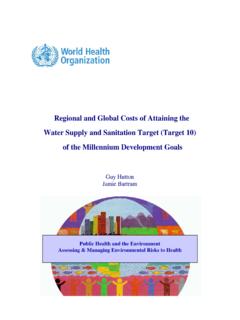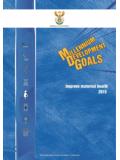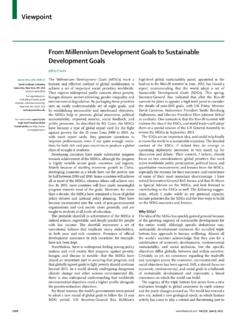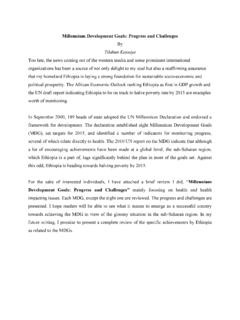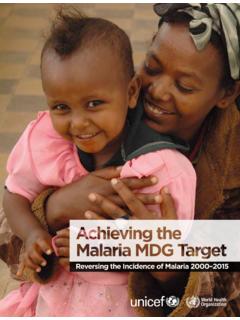Transcription of State of Education in Africa Report 2015
1 State of Education in Africa Report 2015 . A Report card on the progress, opportunities and challenges confronting the African Education sector PHOTO: ARNE HOEL / WORLD BANK. 2 State OF Education IN Africa Report 2015 . PHOTO: MICHELLE MESEN / GLOBAL PARTNERSHIP FOR Education . Executive Summary The African continent is full of tremendous promise. Emerging out of decades of stagnation, the continent is now home to seven of the world's 10 fastest growing economies. The significant strides in Africa 's socio-economic progress have helped to grow a vibrant middle class and propel technological advancements at a rapid pace. Africa is also the world's most youthful continent. Today, nearly 50 percent of Africans are under age 15. Africa 's young people are our future leaders and will be the driving force behind sustainable growth across the continent. Investment in Education and training is essential in building an educated and skilled workforce and to encourage innovation.
2 For this reason, The Africa -America Institute (AAI) is excited about hosting our Second Annual State of Education in Africa conference in Lagos, Nigeria. The conference's overarching goals are: To have a solution-driven conversation with policy-makers, educators, administrators, philanthropists and those interested in capacity-building about the challenges and opportunities in Education on the African continent. To elevate and mainstream the conversation on Education as a key component of the economic development narrative of Africa . To use AAI's convening power, visibility and thought-leadership to uniquely identify the primary obstacles and practical interventions, which must be implemented to improve the educational land- scape in Africa . Educators and innovators from Africa and globally will gather to assess the progress of primary, secondary, tertiary, technical and vocational Education in Africa . Some of the world's leading thinkers and practitioners in Education will offer insights into thematic, country and sector approaches to expanding Education and strengthening the capacity of Africans and educational institutions.
3 Most importantly, the State of Education in Africa conference is designed to be open not just to experts, but to individuals who are committed to improving Africa 's Education sector, and can provide solutions and bold approaches to creating a quality Education . This Report is a starting point for the wide range of discussions that will take place at this conference and beyond. We've gathered data and statistics from a vast body of research from the World Bank and UNESCO. to provide an overview of the State of Education in Africa . The Report Card showcases the considerable progress and achievements in the Education sector in Africa , and also draws attention to critical key areas of improvement. We hope this Report will inspire collective action to sustain progress and develop concrete steps to enhance the Education sector on the continent. Sincerely, Amini Kajunju, President & CEO. State OF Education IN Africa Report 2015 3.
4 This Report provides a snapshot of the progress, to date, and challenges at the primary, secondary, vocational and technical, and higher Education levels. Overview of the State of Education in Africa : Early Childhood, Primary and Secondary Education , Vocational and Technical Training, and Higher Education 4 State OF Education IN Africa Report 2015 . PHOTO: ALBERT GONZ LEZ FARRAN / UNAMID. Introduction The State of Education in Africa 2015 Report offers an opportunity for educators and innovators to gain a regional overview of the African Education sector. Each section gives a brief introduction, key statistics and strategies to consider in moving forward. The Report provides a snapshot of the progress, to date, key statistics, and challenges at the primary, secondary, vocational and technical, and tertiary Education levels. The section on Quality of Education in Africa explores whether students are meeting Education targets and learning outcomes as well as teacher training and effectiveness in African schools.
5 The Public Spending on Education Systems section looks at the investments in Education at all levels by African governments. The Report Card assesses where Education stands today and can guide stakeholders on the key priorities to enhance the African Education system. The key Education indicators were gleaned from World Bank statistics and UNESCO data on a regional level. We hope the Report will guide some of the engaging discussions that will take place on panels and the keynote address at the State of Education in Africa conference and pinpoint areas for innovative solutions to boost educational outcomes. Young people are Africa 's future leaders. We must equip them with the skills and tools for success. That is why AAI is building on more than 60 years of strengthening the human capacity of Africans and promoting the continent's development through higher Education to launch the Future Leaders Legacy Fund.
6 The AAI Future Leaders Legacy Fund provides scholarships to bright, yet under-resourced African students, who would be the first in their family to attend university, with the opportunity to study in top-performing African universities and colleges to earn bachelor's degrees and vocational and technical training certifications. The Fund will also ensure that African universities benefit by receiving increased resources to retain and educate students. We all need to be part of the solution. Join us! State OF Education IN Africa Report 2015 5. EARLY CHILDHOOD Education . Early childhood Education offers positive lasting benefits for children. The early years of a child's life lay the foundation for their socio-emotional development . More often than not, early childhood years will determine whether a child will be successful in school, gain decent employment and income, as well as influence the lives of future generations.
7 In sub-Saharan Africa , only Investing in early childhood development benefits whole societies. Yet, African countries are lagging far behind seven countries achieved other regions in early childhood development . Children enrolled in pre-primary Education programs are more the gross enrollment ratio likely to come from affluent households, although target of 80 percent or more children in low-income communities in Africa would gain the most from such programs. The goal of pre- students in pre-primary primary schools should be to prepare children for Education programs. success in primary school. However, the quality of early Education programs tend to vary significantly from country to country. If early Education programs exist in a country, studies found that teachers are often untrained and schools lack the necessary resources and effective curricula for early childhood development . Key Statistics In 2012, 184 million children were enrolled in pre-primary Education worldwide.
8 Nearly 11 million children were enrolled in pre-primary Education in sub-Saharan Africa in 2008. Globally, 8 of the 10 countries with the lowest pre-primary net enrollment rates are in sub-Saharan Africa . In sub-Saharan Africa , only seven countries achieved the gross enrollment ratio target of 80 percent or more students enrolled in pre-primary Education programs. Yet, enrollment in pre-primary Education programs is expanding throughout Africa . Enrollment rose by almost two and half times between 1999 and 2012. On average, only 20 percent of young children in Africa were enrolled in pre-primary programs in 2012. Source: UNESCO. Moving Forward Pre-primary programs aim to prepare young children to get off to a strong start in their school readiness. Millions of young children under age 5 are not reaching their developmental potential due to few early Education programs. As African governments focus on providing greater educational opportunities to school-aged children, pre-primary school classrooms must be considered.
9 Access to good quality pre-primary Education can improve a child's primary Education outcomes as well as life opportunities. 6 State OF Education IN Africa Report 2015 . PRIMARY Education . Primary Education enrollments in Africa have experienced steady progress since 1999. With the launch in the year 2000 of the millennium development goals (MDG), a set of ambitious devel- opment targets to reduce extreme poverty worldwide by 2015 , many African countries committed to working towards the development goal of achieving universal primary Education . Sub-Saharan Africa has demonstrat- ed the greatest improvement in primary Education enrollments compared to other regions of the world. Many African nations took an important step in the right direction by eliminating school fees to The Africa region has experienced allow more children to attend in primary schools. The result was promising, but maintaining a high an impressive increase in the quality primary Education continues to remain a number of students enrolled in challenge for most countries.
10 Primary school. Between 1990. Key Statistics and 2012, the number of children The Africa region has experienced an im- pressive increase in the number of students enrolled in primary schools more enrolled in primary school. Between 1990 than doubled, from 62 million to and 2012, the number of children enrolled in primary schools more than doubled, 149 million children. from 62 million to 149 million children. In sub-Saharan Africa , 15 countries have abolished school fees since 2000, enabling more children to attend primary school. Despite tremendous gains in primary school enrollment, no African country has achieved universal primary Education . For a country to achieve universal primary Education , all children must have completed a full course of primary schooling. Globally, 58 million children of primary school age were out of school in 2012. Of that number, 38 million children were in Africa . About half of all out-of-school African children will never step foot in a school in their lifetime.

